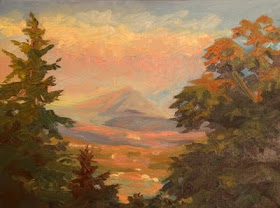ACRYLIC PAINTING TECHNIQUES by Stephen Quiller.
When I picked this book up, I thought I would be discovering a world of acrylic painting techniques that could be applied to watermedia. Those techniques are in the book (divided into thick, oil-like applications and thin, watercolor-like applications) but what really enchanted me in this book were Stephen Quiller’s paintings. Each is filled with surprising, complex color, with startling, expressive harmonies. Beyond that, Quiller is a superb shape maker. His shapes are intricate, balanced, filled with windows, brushed with veils of acrylic color. Forget the acrylic techniques. Give me a book of Quiller paintings and I will sit, rapt for hours. That said, you could pick up this book and learn much about transparent, translucent, and opaque layers, special colors and mediums, and even collage. Tidbits on glazing, resists, and opaque passages are some of the highlights. And as always, Quiller fills his book with his special approach to color relationships. This is a book to study on multiple levels.
When I picked this book up, I thought I would be discovering a world of acrylic painting techniques that could be applied to watermedia. Those techniques are in the book (divided into thick, oil-like applications and thin, watercolor-like applications) but what really enchanted me in this book were Stephen Quiller’s paintings. Each is filled with surprising, complex color, with startling, expressive harmonies. Beyond that, Quiller is a superb shape maker. His shapes are intricate, balanced, filled with windows, brushed with veils of acrylic color. Forget the acrylic techniques. Give me a book of Quiller paintings and I will sit, rapt for hours. That said, you could pick up this book and learn much about transparent, translucent, and opaque layers, special colors and mediums, and even collage. Tidbits on glazing, resists, and opaque passages are some of the highlights. And as always, Quiller fills his book with his special approach to color relationships. This is a book to study on multiple levels.

















































